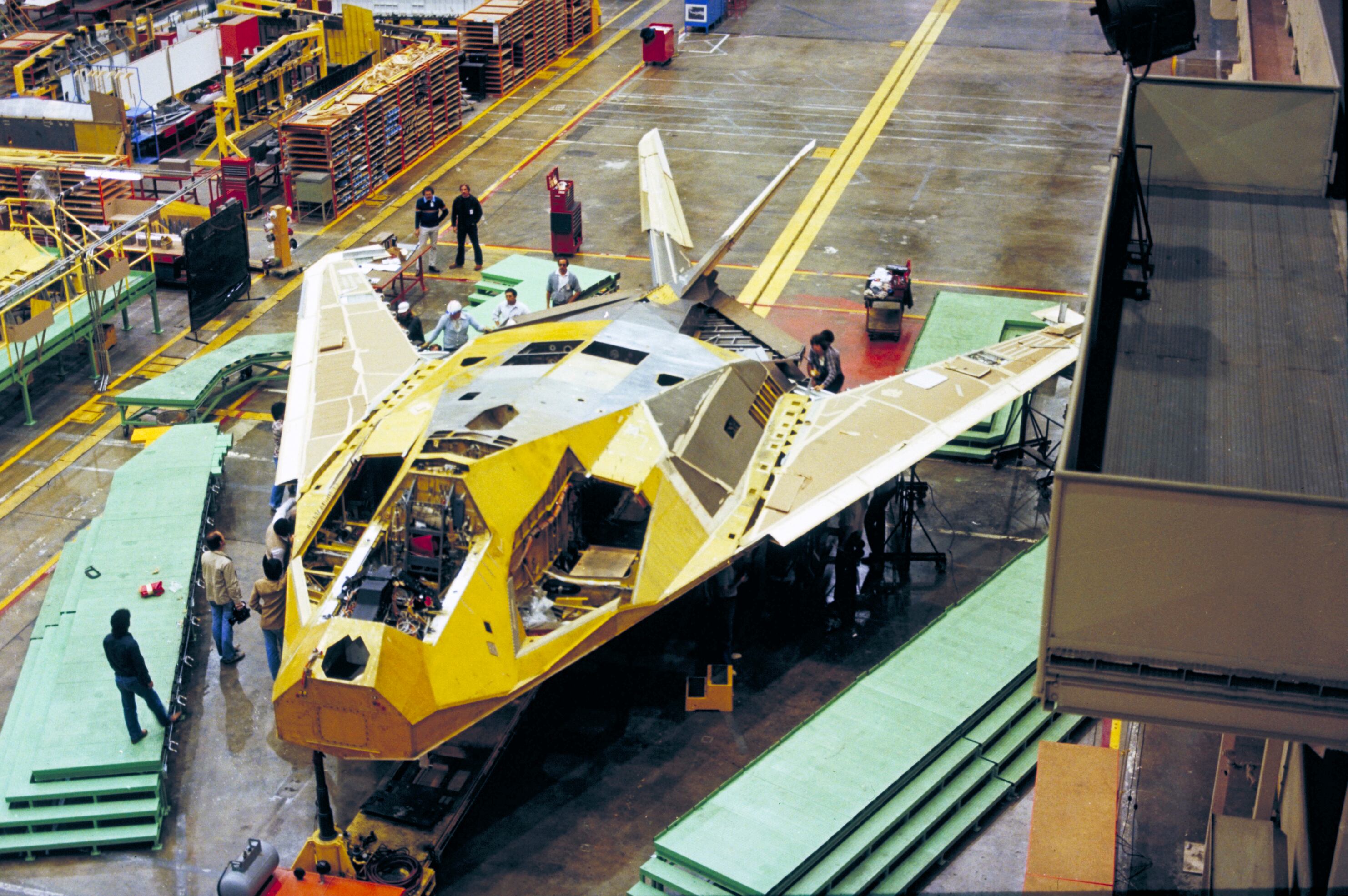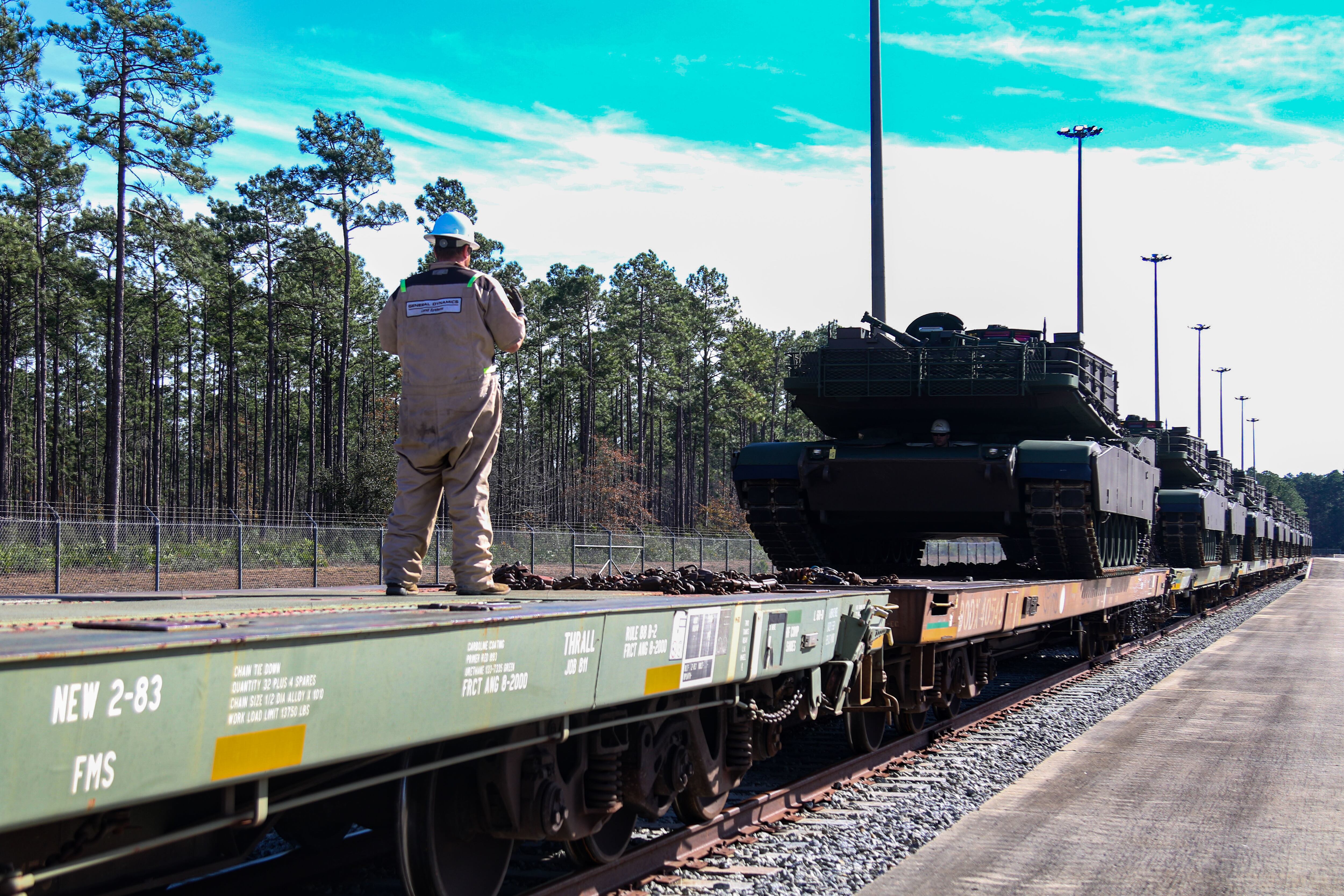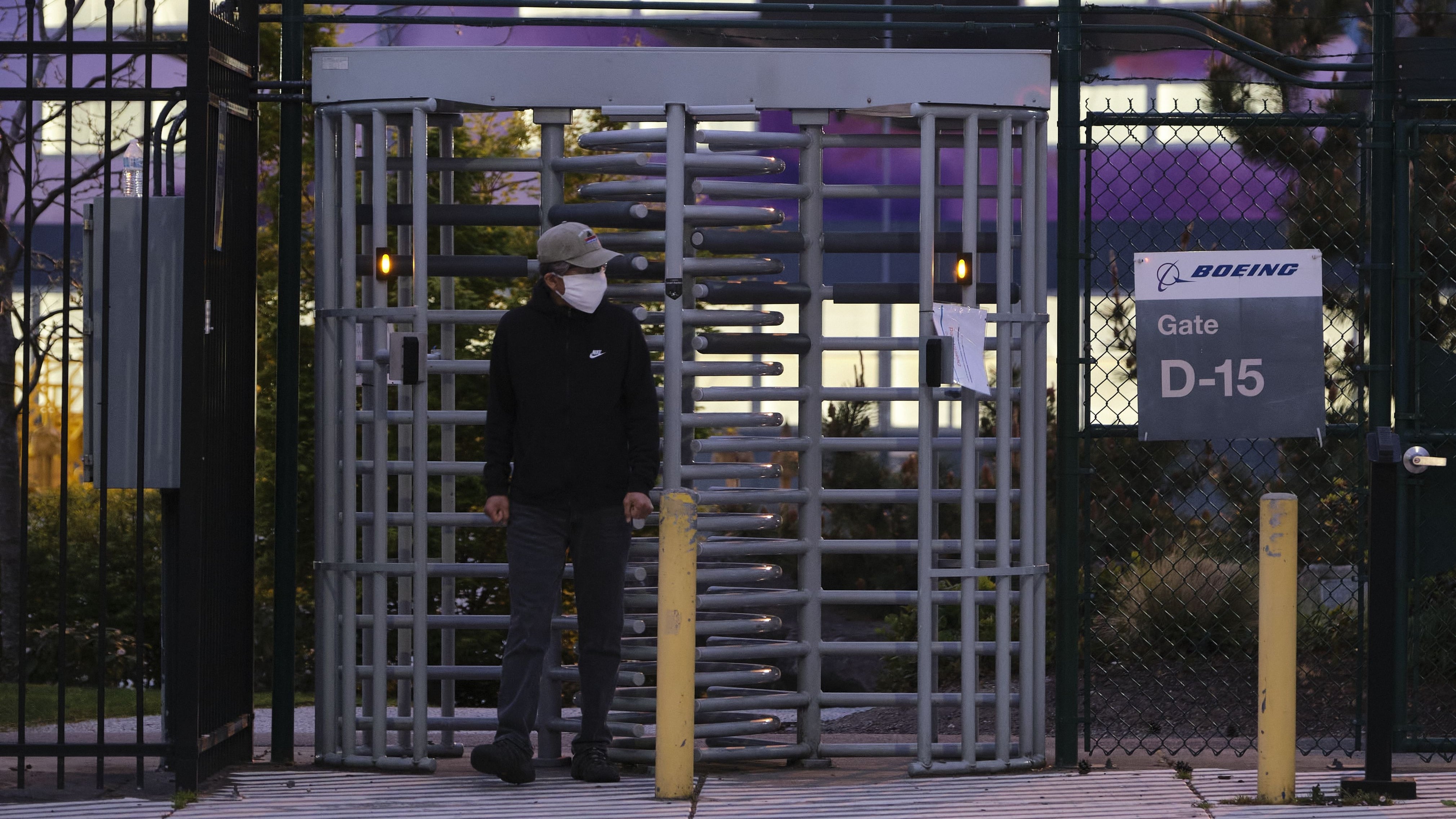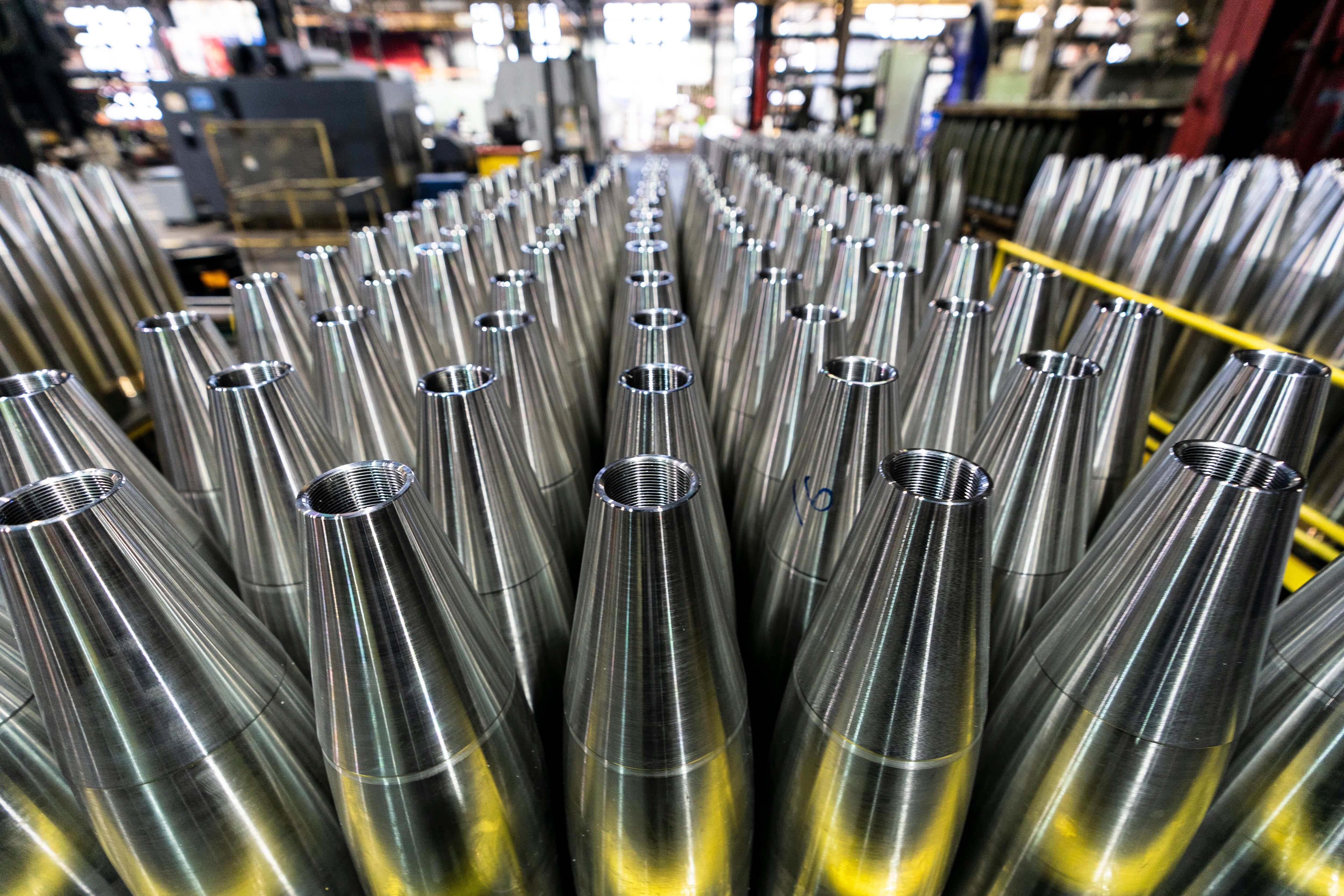WASHINGTON — About two dozen leaders from the defense industry joined the secretary of defense for dinner in fall 1993. After the meal, later known as “the Last Supper,” came a half-hour briefing.
The topic was consolidation. The Cold War was over, which meant America would spend less on defense. That also meant less money for the companies in the room. Officials flashed a black-and-white graph onto the wall, showing a plunge in how many contractors the Pentagon could afford. Companies would likely need to merge if they wanted to survive.
Norm Augustine — then-chief executive of Martin Marietta, which itself merged in 1995 to become Lockheed Martin — had been there, sitting beside the defense secretary. A day later, he returned to the Pentagon and grabbed a copy of that chart, expecting it to be a historic document. He still has it today.
Within a decade, the number of large prime contractors plummeted from 51 to five, creating the modern defense industry. Lockheed merged with Martin. Boeing merged with McDonnell Douglas.
“Sitting there at the Last Supper, I felt like I was sitting in a historical pivot point,” Augustine told Defense News. “They did the best [with] a bad hand, and we’re now paying the price for the bad hand.”

That price is a defense sector that can’t move as quickly as the Pentagon wants it to. America is now supplying materiel for the wars in Ukraine and Israel, which started a year and a half apart. The high demand has strained an industry that often struggled to meet needs long before Russia’s full-scale invasion of Ukraine in February 2022.
And these wars aren’t even the Defense Department’s top priority; that’s China, whose massive military buildup over the last 20 years is the pace America’s leaders say they must match. Nowhere is this clearer than in the Pentagon’s new defense-industrial strategy, which says China’s industrial might in many areas “vastly exceeds” that of the U.S. and its allies.
In response, the plan calls for “generational” investment in the industrial base. To do so, the Pentagon is now showing a new set of graphs.
Bill LaPlante, the department’s top weapons buyer, has a wall in his office covered with images plotting how long it would take to build more missiles and other munitions. His deputies are sharing these with company after company, he said — though the Pentagon isn’t making them public.
Call it a tale of two charts: In 30 years, the Pentagon went from a defense industry it considered too large to sustain, to one now too small to surge. To understand that path, Defense News spoke with analysts and industry executives as well as top industrial base policy officials dating back to the Clinton administration. They likened the sector to something of a spring-loaded door — where capacity slammed shut due to smaller budgets, changing preferences and a thinning workforce.
That door is now creaking open again as America retools its defense industry, workforce and suppliers to compete with an advanced adversary.
“It’s dusting off a lot of skills that we’ve had in this country that we haven’t used in a while,” LaPlante told reporters in December at the Reagan National Defense Forum.
Industrial base 101
Experts on America’s defense industry tend to speak about it like an intro economics course. They often note the sector doesn’t move like other markets.
Defense companies build what governments want, but rarely any more or anything different. The Pentagon’s orders, hence, have an unusual amount of sway over the shape of the companies fulfilling them.
“The defense industry is hypersensitive to and responsive to its customers,” said Steve Grundman, a senior fellow at the Atlantic Council think tank.
Grundman worked in the Pentagon in the 1990s, in the wake of the peace dividend. Military spending had surged under the Reagan administration as the U.S. competed with the Soviet Union. But when the USSR dissolved in 1991, ending the Cold War, America had no opponents left to outcompete. Defense spending fell each fiscal year from 1985 to 1998, according to the Center for Strategic and Budgetary Assessments think tank.
Specifically, the Pentagon’s spending on procurement, research, development and construction dropped 44% during that time period, CSBA found.
America needed a defense industry built for peacetime. So arrived the Last Supper, a name Augustine himself gave the 1993 dinner. Even at the time, he said, it appeared to be sound policy. Defense spending was bound to fall, leaving the Pentagon with two choices: a sprawling industry versus a smaller, more efficient one.
Defense officials encouraged the latter. Alongside the plummet of prime contractors, the number of mid-tier and small suppliers also cratered as companies merged in order to lower costs.
Eventually the government said enough was enough. In the late 1990s, it blocked Lockheed Martin’s plan to buy Northrop Grumman. The era of major consolidation was over.
Its effects were twofold: less competition and less ability to surge. The first, in many cases, has meant the Pentagon’s orders take longer, cost more and are vulnerable to brittle supply chains. The second — caused both by consolidation and more efficient manufacturing techniques — makes it harder to respond to sudden conflicts.
Heading into the 2000s, leaders in large part began to favor weapons that were more advanced but would be fewer in number. Defense Secretary Donald Rumsfeld labeled it a “transformation” that would vault the Pentagon’s arsenal a whole generation ahead.
Some of these advanced weapons — such as the Army’s Future Combat System and the Navy’s Littoral Combat Ship — did not work out as intended. And the shift toward fewer, more capable systems further encouraged companies to consolidate.
In 1998, five companies built surface ships and two made tracked combat vehicles. By 2020, those numbers had fallen to two and one respectively.

“As dumb as it sounds, given how much we spend on defense, oftentimes the volume for any single supplier isn’t enough,” said Dave Bassett, a retired Army lieutenant general, who until December ran the Defense Contract Management Agency.
‘A wake-up call’
The peace dividend did not survive America’s wars in Iraq and Afghanistan.
The 9/11 attacks followed by the two conflicts swelled the Defense Department’s budget. When adjusted for inflation and including supplemental funding, Pentagon spending rose an average of 7% from fiscal 1999 to fiscal 2008, according to CSBA.
This spending went toward a new set of threats.
As an example, Bassett and other experts interviewed by Defense News singled out a class of heavily armored vehicles developed for the wars. The mine-resistant, ambush-protected vehicle program was Defense Secretary Bob Gates’ top priority. With heavy investment, the Pentagon fielded more than 13,000 MRAP vehicles in three years.
The program has since become a talisman for some who argue the defense industry can move nimbly if given the proper resources. But it’s also a reminder of where those resources went for more than 15 years. From 2001 onward, the Pentagon needed weapons for counterinsurgencies.
Those are far from what Ukraine needs to defend itself against Russia — an industrial-age war defined by the use of artillery and small drones. Even further are the needs of defending Taiwan, an island nation threatened by a leading manufacturing powerhouse.
“If what you’re facing is an Iraqi threat, you’re probably not going to have the same capacity as when you face a Russian and the Chinese threat,” said Bill Lynn, deputy defense secretary during the Obama administration and now chief executive of Leonardo DRS.
And the change in capacity had become clear to defense officials.
Brett Lambert, who ran industrial base policy for the Pentagon while Lynn was deputy secretary, remembers a tornado in 2011 that struck Joplin, Missouri — nearly hitting a major battery supplier.

“We realized that even though the plant itself was not hit, we didn’t have a backup,” Lambert said. “That was a wake-up call to me.”
Another warning came in the form of a four-year study of major weapons programs Lambert helped lead. He found, in large part, that prime contractors didn’t understand their own supply chains.
But while the alarm went off, no one woke up, said Robert Lusardi, a former Pentagon industry official. The study’s data, he noted, largely faded into the ether.
“Nobody used it,” he said.
‘There’s never just one problem’
Eric Chewning was vacationing with his family at the Outer Banks in summer 2017.
Sitting on the North Carolina beach with his kids, Chewning — then a partner at the consulting firm McKinsey and Co. — scrolled through his phone and saw a news release about an executive order. President Donald Trump was instructing the Pentagon’s first top-down review of its defense-industrial base since the Eisenhower administration.
“I say to myself: ‘Who are they going to get to do that?’ ” Chewning told Defense News in an interview.
Later that day, he was walking back from the beach when he got a call from the Pentagon asking if he would interview for the top industrial base policy role. In October, he took the job, which meant he would be the one running the study.
“The mindset was: How do we holistically now transition ourselves from the post-9/11 wars, where there really wasn’t ever a question around our ability to generate enough material capability, to one focused on competition with an economic peer?” Chewning said.
What he found is that doing so wouldn’t be easy — in large part because of what was happening with the American workforce. By the time the defense industry consolidated in the 1990s, the U.S. was decades into a deep manufacturing slide.
From the late 1970s to 2017, the country lost 7.1 million manufacturing jobs, or 36% of the sector’s workforce, according to the study Chewning led. Such declines serve as a challenge to any attempt to quickly bulk up America’s defense industry. Even with more advanced factories that now heavily rely on robotics, weapons still need people who know how to build them.
This is part of why capacity is so difficult to add once it’s gone, said Bassett, the retired Army general. It takes years to find and train skilled workers, as companies across the country have seen in the recently tight labor market.
While leading the Defense Contract Management Agency, Bassett studied business traits that would help predict manufacturing problems. A significant one he found was the share of blue-collar employees who had been on the job for less than a year; once it reached a certain threshold, he said, quality issues were almost guaranteed.
While the 2018 study led to some reforms, it did not reverse the trend in manufacturing, which only got worse as older workers retired en masse during the COVID-19 pandemic. Like many reports in Washington, it pointed to major issues that existed alongside other difficulties, all competing for time and money.

“There’s never just one problem,” said Chewning, now a vice president at the shipbuilder HII. “The immediate problems get the most attention.”
By 2022, the problem had become immediate. Russia launched a full-scale invasion of Ukraine, and Washington continued sending weapons to aid Kyiv.
The U.S. has given Ukraine a staggering amount of security aid — more than $44 billion since February 2022. Despite that sum, one of the lessons for many in the Pentagon has been that industry was unprepared for a crisis.
Arguably, nowhere is this more obvious than in America’s supply of 155mm artillery shells.
The 155mm round — next to small drones – has defined fighting in Ukraine. For self-defense, Kyiv needs 60,000-80,000 shells per month, Michael Kofman, an analyst at the Carnegie Endowment for International Peace, told Defense News.
That rate well surpasses the pace at which Ukraine’s Western allies could resupply them. Even with an extra $1.5 billion from Congress in 2023 to increase production, America was making 28,000-30,000 shells in December, said LaPlante, who is in charge of acquisition and sustainment at the Pentagon.
The Defense Department’s goal is to reach 100,000 rounds per month by the middle of 2025. But that pace likely won’t be possible without more funding from Congress, which has stalled a security spending bill requested by the White House.
But funding hasn’t slowed down production in recent years; from FY16 to FY23, Congress added 7.3%, or $79.3 billion, to the White House’s requested Pentagon procurement fund, according to CSBA. The problem is inconsistent demand, which LaPlante illustrated with another chart last fall.
Starting with the Gulf War 30 years ago, munition orders have gone up and down in a series of peaks and valleys: A crisis breaks out, the Pentagon surges supply, it reaches the number a couple years later, then the crisis wanes and supply falls.
“That’s one of the challenges that we have now — that inability to make adjustments because of the lack of investment that we’ve made to the industrial base historically,” Justin McFarlin, who leads industrial base development for the Pentagon, told Defense News.
Munitions are often at high risk for such whiplash. Eric Fanning noticed this pattern after years of holding senior positions with the Navy, the Air Force and the Army. Much of each service’s spending power was sewed up in large systems, such as aircraft carriers and fighter jets. More inexpensive items ended up tapered to make the budget fit. And because the Pentagon’s demand affects supply, the companies fulfilling those orders trimmed capacity over time.

Now orders are up again — this time for 155mm shells and a bevy of other munitions. For some, Congress has allowed the Pentagon to issue long-term contracts that keep demand stable for years. But for others, companies are left worrying government demand won’t last, according to Fanning, now head of the Aerospace Industries Association.
“That sense of long-term commitment is still not quite there,” he said.
‘First contact with the enemy’
The Pentagon says it’s signaling future commitments in its new industrial base strategy. The document focuses on four areas: creating resilient supply chains, ensuring workforce readiness, creating business-friendly acquisition policies and bolstering the national security marketplace.
“These are not new ideas,” Halimah Najieb-Locke, acting deputy for industrial base policy, told Defense News. “But they haven’t been said with the [needed] authority.”
In a separate briefing with reporters in January, Najieb-Locke previewed the Pentagon’s goals for its defense-industrial base over the next three to five years. One is to speed up long-lead items, such as ball bearings or solid-rocket motors that slow down the production of important weapons. Others include retooling obsolete parts of the supply chain and using more funding from the Defense Production Act, which allows the Pentagon to issue national security-related grants.
“We no longer can afford to ignore [issues in the industrial base] and hope for better,” Najieb-Locke told Defense News. “We have to take decisive action.”
But there are problems outside of the Pentagon’s control.
The first is politics. As of publication, Congress had yet to pass a full defense spending bill — the latest entry in more than a decade of continuing resolutions. Defense remains a largely bipartisan issue, but there is a widening gap within the Republican Party — one reason Congress hasn’t passed additional aid for Ukraine, Israel and Taiwan.
Today’s security environment “demands a substantial, long-term increase in resources for our national defense,” Sen. Roger Wicker, R-Miss., the ranking member of the Senate Armed Services Committee, told Defense News in a statement.

Some of his colleagues in the House are more skeptical. “The American people work diligently to earn every dollar, but it seems the [Defense Department] has become a master of squandering those funds without batting an eye,” Rep. Glenn Grothman, R-Wis., told Defense News in December.
The second external problem is innovation. In decades past, the Pentagon used to be upstream of new technology — think GPS or the internet. It’s since found itself downstream, said Lynn, the former deputy defense secretary, and much of the current advances in artificial intelligence and drones are coming from the commercial sector.
Learning how to better work with these companies is one of the strategy’s goals. Doing so, said Najieb-Locke, will involve updating the Pentagon’s buying policies to better align with the commercial sector — a market that the Pentagon has less influence over.
“Because of that rapid change [in technology], a lot of our assumptions of what will be there in time of need have [proved] to be in some cases overblown,” said Najieb-Locke.
A third challenge is America’s adversaries. The Russia-Ukraine and Israel-Hamas wars are a reminder that competitors ultimately help decide how fast America’s defense industry must work, and when.
Chris Michienzi learned this lesson from her time working on the Pentagon’s industrial base policy. For about eight years she helped steer the department’s approach to industry and saw challenges evolve. When the war in Ukraine began in 2022, she was one of a few officials working on aid to Kyiv.
Many of the problems of the last 30 years were on display. A worker shortage hampered attempts to surge key munitions, she cited as an example.
“The department gets the industrial base that it pays for,” she said.
Michienzi left her post last summer. In January, when Defense News spoke with McFarlin, who leads industrial base development for the Pentagon, the interview took place in Michienzi’s old office — a small, windowless cube.
No one had filled the space, and it was instead turned into a conference room — helpful for McFarlin as he briefed companies on the government’s new strategy.
“The saying I grew up [with] was: No plan survives first contact with the enemy,” McFarlin said. “We can plan, but we also have to be able to pivot and adjust.”
Noah Robertson is the Pentagon reporter at Defense News. He previously covered national security for the Christian Science Monitor. He holds a bachelor’s degree in English and government from the College of William & Mary in his hometown of Williamsburg, Virginia.





